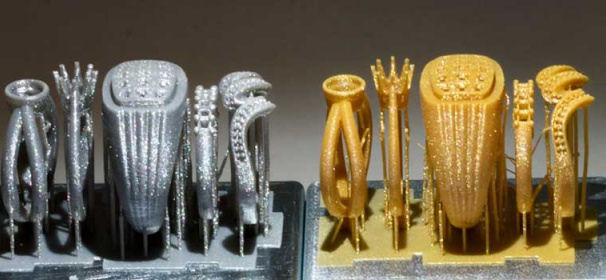Editor’s Pick: 3D Systems Unveils New Production-Level 3D Printers

New materials for the ProJet 1200 3D printer from 3D Systems extend the range of applications it can handle for manufacturers, engineers, dental labs, jewelers and 3D artists. Image courtesy of 3D Systems Inc.
Latest News
December 3, 2014
 Dear Desktop Engineering Reader:
Dear Desktop Engineering Reader:
 While many of us in the U.S. were interrupting our work with that fowl Thanksgiving business, the EuroMold technology fair was hopping in Frankfurt, Germany. 3D Systems (3DS) had a big footprint at the show, where it introduced its next generation of 3D production systems, a new version of one of its popular professional-level 3D printers, new materials and a new scanner-based 3D design and inspection solution. Lots to touch on here, so let’s get cracking.
While many of us in the U.S. were interrupting our work with that fowl Thanksgiving business, the EuroMold technology fair was hopping in Frankfurt, Germany. 3D Systems (3DS) had a big footprint at the show, where it introduced its next generation of 3D production systems, a new version of one of its popular professional-level 3D printers, new materials and a new scanner-based 3D design and inspection solution. Lots to touch on here, so let’s get cracking.
The new 3D production-level systems 3DS announced are the ProX 800, the ProX 500 Plus and the ProX 400. The ProX 800 is available immediately. The other two will come out in 2015, with the ProX 500 Plus available first sometime early in the year.
The ProX 800 is an SLA (stereolithography) machine that’ll let you build fab-grade plastic prototypes, end-use parts, casting patterns, rapid tooling, fixtures and so forth. It has a new laser print head and uses print material management techniques that, 3DS says, lower its total cost of ownership. It has smaller dimensions than its predecessors, requiring up to 50% less floor space, but it has a large build area. Three actually, ranging from 25.6 x 29.5 x 1.97 in. to 25.6 x 29.5 x 21.65 in. Accuracy ranges from 0.001 to 0.002 in. per inch of part dimension.
The ProX 500 Plus SLS (selective laser sintering) system is an enhanced version of the widely deployed ProX 500 3D printer. The crucial difference is that it has more material options. The ProX 500 Plus can fabricate end-user parts with smooth surface finishes with three new high-performance materials: glass-filled, aluminum-filled and Nylon 11. This means you can build aircraft and automotive parts, complex housings and enclosures. The print envelope is a good-sized 15 x 13 x 18 in., and layer thickness ranges from 0.003 to 0.006 in.
Speaking of a big footprint, the ProX 400 DMP (direct metal printing) unit has the largest build area of any metal 3D printer in the 3DS line-up: 19.69 x 19.69 x 19.69 in. A dual-laser system, the ProX 400 offers factory production features such as automated finishing and a modular design. It can make industrial-grade metal parts and complex molds in over a dozen alloys and ceramics, including aluminum, cobalt, chrome, maraging steel, stainless steel and titanium.
3DS also released new materials for its professional-level ProJet 1200 and its ProJet 5500X MultiJet 3D printers. The ProJet 1200 sees five new materials that should expand its range of applications for engineers, manufacturers, dental labs, jewelers and 3D artists. The new gray and clear materials add to the company’s portfolio of material options for small end-use parts and presentation models for engineers as well as figurines and design creation for 3D artists. New cast, gold and silver materials give jewelers a digital prototyping and production workflow.
The ProJet 5500X now has new black and translucent materials that 3DS says are tough, functional-grade, flexible elastomers that provide you new versatility for printing out models, functional prototypes and end-use parts. The new offerings also mean that the ProJet 5500X can create models with up to 14 unique materials.
After four new 3D printers and a passel of materials, 3DS announced the Capture Mini. This is neat. Capture Mini is a member of the Geomagic Capture family of integrated blue light LED scanners and software for scan-based design and quality inspection on the professional level. What Capture Mini brings to the clan is a system tailored for small, precise parts such as small mechanical parts, jewelry and dental models.
You can learn a lot more about all of these products by starting your investigation with today’s Pick of the Week write-up. You’ll find links to the individual machines, brochures and, where available, to short video overviews. Really good stuffing, er, stuff here from 3D Systems.
Thanks, Pal. — Lockwood
Anthony J. Lockwood
Editor at Large, Desktop Engineering
Read today’s pick of the week write-up.
This is sponsored content. Click here to see how it works.
Subscribe to our FREE magazine, FREE email newsletters or both!
Latest News
About the Author
Anthony J. Lockwood is Digital Engineering’s founding editor. He is now retired. Contact him via [email protected].
Follow DE





